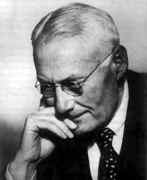Person: Nielsen (2), Jakob

Jakob Nielsen was a Danish mathematician best known for his work on automorphisms of surfaces.
Mathematical Profile (Excerpt):
- His relations with his aunt deteriorated, however, and Nielsen left her home when he was fourteen and he continued at school but earned his living by tutoring.
- Nielsen did not let this damage his education but continued to study on his own.
- Among the teachers at Kiel who had a profound influence on him was Landsberg who suggested the topics which were to form Nielsen's doctoral thesis, although Landsberg died before the thesis was completed.
- Nielsen spent the summer term of 1910 at the University of Berlin but returned to Kiel where Dehn was appointed in 1911.
- Dehn greatly influenced Nielsen and introduced him to the newest ideas in topology and group theory.
- After completing his doctorate Nielsen served in the German marines, continuing in military service in different parts of the world throughout World War I.
- At the end of the war Nielsen returned from Turkey to Germany through Russia and Poland and he later published an account of his travels from a diary which he had kept.
- Nielsen spent time in 1919 in Göttingen where he met Hecke.
- When Hecke was appointed to Hamburg in 1919, Nielsen went as his assistant, but the following year Nielsen was appointed to a chair at Breslau.
- This allowed Nielsen to become a colleague of Dehn who was a professor there.
- In 1921 Nielsen, who was born in Schleswig, elected to became a Danish citizen and he resigned his chair in Breslau and returned to Denmark to teach in Copenhagen.
- In 1919 Nielsen purchased a house on the island of Als on which he was born.
- Nielsen wrote a new text on theoretical mechanics which was published in two volumes in 1933-34.
- The text is not very easy, and Jacob Nielsen's lectures were rather demanding on the part of the students.
- There were some fears for Nielsen's safety during World War II.
- These fears were not realised and Nielsen was not targeted by the Nazis.
- Nielsen taught a course on aerodynamics in 1941 and the course formed the basis of a third volume of his theoretical mechanics text published in 1952.
- In 1951 Nielsen succeeded Harald Bohr as professor of mathematics at the University of Copenhagen.
- It might seem a strange decision for Nielsen to resign this prestigious chair, but he was sixty-five years of age in 1955 and he felt that his international commitments were too much to allow him to do full justice to all his tasks.
- Nielsen is well known for work in several areas.
- Nielsen studied the mapping class group of a torus in his thesis of 1913.
- Other papers appeared in various Scandinavian periodicals or conference proceedings, many of them in Danish: the majority of them, and also many of Nielsen's papers in German, have for this collection been translated into English.
- Among them is his fundamental paper, in the Matematisk Tidsskrift in 1921, on free groups, in which the Nielsen-Schreier theorem (or rather Nielsen's part of it) is proved for the first time: now there is no further excuse for misquoting this paper, as has happened repeatedly in the past.
- There was however, some work by Nielsen which was not published in his collected works.
- This piece of mathematics, now known as Fenchel-Nielsen theory, had a rather strange history.
- Fenchel and Nielsen decided to write a monograph on the theory but neither were happy with the first draft of the manuscript which they produced.
- They were working on a revision when Nielsen died in 1959 after an illness lasting about eight months.
- Eventually Fenchel wrote a book Elementary geometry in hyperbolic space which was intended to put give an approach with would make presentation of Fenchel-Nielsen theory much clearer.
Born 15 October 1890, Mjels, Als, Schleswig (now Denmark). Died 3 August 1959, Elsinore, Denmark.
View full biography at MacTutor
Tags relevant for this person:
Algebra, Group Theory, Origin Denmark
Thank you to the contributors under CC BY-SA 4.0! 

- Github:
-

- non-Github:
- @J-J-O'Connor
- @E-F-Robertson
References
Adapted from other CC BY-SA 4.0 Sources:
- O’Connor, John J; Robertson, Edmund F: MacTutor History of Mathematics Archive
